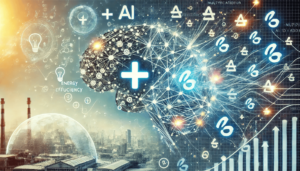AI on the Cyber Frontline: The Double-Edged Sword

Illustrating the dynamic intersection of artificial intelligence and cybersecurity, where advanced AI algorithms and cybersecurity defenses merge in a futuristic digital landscape." Illustrating the dynamic intersection of artificial intelligence and cybersecurity, where advanced AI algorithms and cybersecurity defenses merge in a futuristic digital landscape.
- How are hackers utilizing AI like ChatGPT to enhance cyberattacks?
- What is the role of WhiteRabbitNeo in both offensive and defensive cybersecurity operations?
- How is Microsoft responding to AI-enabled cyber threats with its development of Security Copilot?
In a rapidly evolving digital world, the intersection of artificial intelligence and cybersecurity is becoming increasingly complex. The recent announcement by Microsoft and OpenAI, as reported by The Verge, that cyber attackers are harnessing AI to enhance their tactics underscores a pivotal shift in cyber threat dynamics. This development signals a new era where the tools designed to streamline and safeguard our digital interactions are now being co-opted to undermine them, necessitating a reinvigorated approach to cyber defense. As we grapple with these advancements, the imperative for vigilant, innovative cybersecurity strategies has never been clearer.
The AI Arms Race
The emergence of AI in cybersecurity presents a paradox: while offering new avenues for protection, it simultaneously empowers adversaries with advanced tools for cyberattacks. This dual-edged nature of AI in cybersecurity underscores the importance of a proactive and dynamic defense strategy that evolves with the threats. As detailed in an article from The Verge, Microsoft and OpenAI’s insights into the adoption of AI by hackers for refining cyberattacks highlight the urgent need for innovation in cybersecurity measures, where the use of AI can be a game-changer in both offense and defense. These developments’ full scope and implications underscore the necessity for continuous vigilance and the development of sophisticated AI-driven security protocols.
The Breakthrough of AI: WhiteRabbitNeo Enters the Scene
In response to these threats, a new player has emerged: WhiteRabbitNeo. This AI model is available on huggingface.co serves dual purposes in both offensive and defensive cybersecurity operations. As it enters public preview, the cybersecurity community is poised to assess its impact on society and its potential to counteract sophisticated AI-assisted threats.
The model WhiteRabbitNeo signifies a notable development in AI’s role in cybersecurity. The 13B version is designed to explore the dual nature of AI in cyber operations, offering a glimpse into the future of cyber defense and offense. It’s a tool for assessing how such AI impacts societal structures and security norms. As AI becomes integral to cybersecurity strategies, models like WhiteRabbitNeo will be crucial in understanding and shaping the ethical framework surrounding their deployment. This move underscores the importance of preparedness against AI-powered cyber threats and the potential of AI to reinforce cybersecurity measures.
Revealed Contents: A Glimpse into AI-Enhanced Cyber Tactics
The Strontium group’s use of AI to delve into satellite communications and radar technologies exemplifies the advanced capabilities that adversaries are now harnessing. Similarly, North Korean and Iranian groups’ employment of AI for phishing and evasion techniques showcases the diverse applications of AI in cyber warfare.
The use of AI by the Strontium group is a stark demonstration of how cyber warfare is evolving. These advancements allow for intricate analysis of highly technical domains, such as satellite and radar communications, suggesting a significant leap in the threat landscape. North Korean and Iranian groups similarly leverage AI to fine-tune their cyberattacks, using it to draft convincing phishing campaigns and develop code that can bypass antivirus software, indicating a broadening scope of AI’s application in cyber strategies. This reveals a trend where AI is not only a tool for defense but is increasingly instrumental in offensive cyber operations.
Broader Implications: Ethical and Strategic Conundrums
The adoption of AI by cybercriminals raises critical ethical questions and strategic challenges. It underscores the need for a balanced approach in AI development, where the same tools that can defend against threats can also be used to perpetrate them.
The integration of AI into cyberwarfare is reshaping the strategic landscape. As adversarial groups utilize AI for surveillance and to craft more sophisticated cyberattacks, the ethical dilemmas intensify. This dynamic underscores a pressing need to navigate the delicate line between innovation and regulation. As AI models like WhiteRabbitNeo demonstrate their dual-use potential, the cybersecurity community faces the challenge of harnessing such tools responsibly, ensuring they serve to protect rather than harm, and maintaining a strategic edge without crossing ethical boundaries
Future Possibilities and Challenges: Towards an AI-Defended Cyberworld
Microsoft’s development of the Security Copilot represents a leap toward an AI-defended cyberworld. This tool aims to empower cybersecurity professionals with AI assistance in breach identification and signal analysis, presenting a new frontier in cyber defense.
With Microsoft developing Security Copilot, the cybersecurity landscape is poised for a transformation. This AI assistant is not merely a tool; it’s a harbinger of a future where AI plays a pivotal role in cyber defense. Imagine a world where cybersecurity professionals are not overwhelmed by the deluge of data and signals but are adeptly assisted by AI, making breach identification and analysis more intuitive and effective. This innovation could redefine the dynamics of cyber warfare, ensuring that defenders are always a step ahead. The Security Copilot exemplifies a shift towards leveraging AI’s potential to create a safer digital environment, representing a significant advancement in our approach to cyber threats.
Navigating the AI-Enabled Cyber Terrain
As we navigate the AI-enabled cyber terrain, it’s clear that artificial intelligence will play a pivotal role in shaping cybersecurity’s future. The dual-use nature of AI tools like ChatGPT and WhiteRabbitNeo necessitates a fine balance between innovation and ethical responsibility. As these tools become more integral to offensive and defensive strategies, the cybersecurity community must remain vigilant, constantly updating and refining AI algorithms to stay ahead of malicious actors.
This AI-driven arms race in cyberspace presents both opportunities and risks. On one hand, AI can streamline the detection of cyber threats, analyze vast amounts of data to pinpoint vulnerabilities and assist in crafting strategies that protect digital assets. On the other, the accessibility of these powerful tools means they can also be exploited for nefarious purposes, making it a constant battle to secure networks and information.
The future of cybersecurity will undoubtedly rely on AI’s capabilities, but it will also depend on the human element—the strategists, ethical hackers, and policymakers who guide the development and deployment of these technologies. As we tread into this new era, the need for international cooperation and regulation becomes more apparent, intending to establish norms and frameworks that ensure the responsible use of AI in maintaining global cybersecurity.
In the age of AI, our vigilance must be as dynamic and adaptable as the technologies we depend on, ensuring that as we harness the power of AI, we also safeguard the principles of security, privacy, and trust that underpins the digital world.




